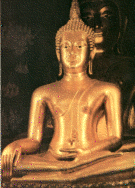3rd Year Week 6 TT05
Topic: Religions
Translate the following into Chinese
History of BuddhismBuddhism
is a religion which is based on the teachings of Siddhartha Gautama, the son
of a wealthy landowner born in northern India around 560 B.C. In order to
achieve spiritual peace, Gautma renounced his worldly advantages and became
known as Buddha, or "the enlightened one". He preached his religious views
his entire life throughout South Asia. The story of Gautma's path to enlightenment has mythological quality. The son of a ruler, a prophecy at the time of his birth said that he would be a great king if he stayed at home, but would become a savior for mankind if he were to leave home. Therefore, his father kept him at home and surrounded him with all the worldly pleasures a boy could want, and kept all painful and ugly things out of his sight. Gautma eventually married and fathered a son, but still had not left his father's palace. One day, he told his father that he wished to see the world. This excursion would change his life, for during this journey, he saw the "four passing sights". Even though his father had ordered the streets to be cleaned and decorated and all elderly or infirmed people hidden, some people did not listen. Gautma saw a decrepit old man, and learned for the first time that everyone someday becomes old. Next, he met a sick man, who taught him that people are liable to sickness and suffering. He saw a funeral procession which taught him that people die. Lastly, he saw a monk begging for food. He longed for the tranquility which he saw on the monk's face and decided this was the lifestyle for him. He left his father, wife, and son to live on the streets and meditate. While in meditation, he reached the highest degree of God-consciousness, nirvana. He stayed under a fig tree which was later called the bodhi or bo tree (the tree of wisdom) for seven days. During this time, he learned truths which he, Buddha, would impart to the world until his death at age 80. Buddhism became a strong force in India before Buddha's death. The diffusion of Buddhism, however, was limited until the Indian emperor Asoka became a convert and supported missionary activities. Soon, Buddhism became established in China, Japan, Korea, and Southeast Asia, where it is most practiced today. Hinduism is now the predominant Indian religion. References McDowell, Josh and Don Stewart, Handbook of Today's Religions. Nashville: Thomas Nelson Publishers, 1983. Twelfth printing, June 1992. Shelley, Fred M. and Audrey E. Clarke, eds. Human and Cultural Geography. Dubuque, Iowa: Wm. C. Brown Publishers, 1994. Images 'Buddha' courtesy of World Religions In Images Written by Sara Wenner, 2001
|
